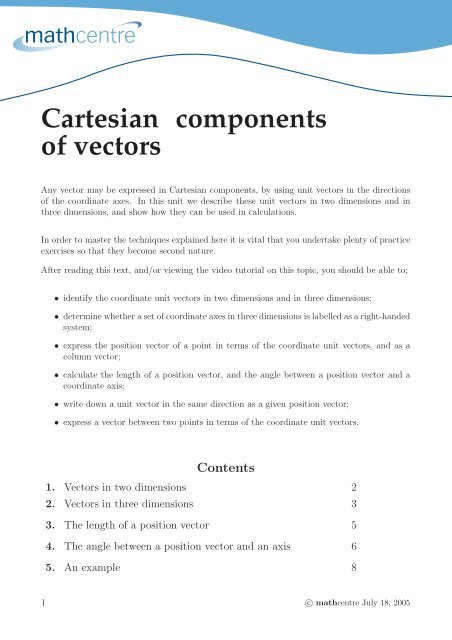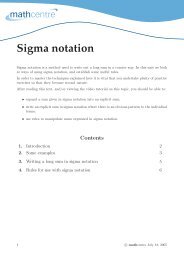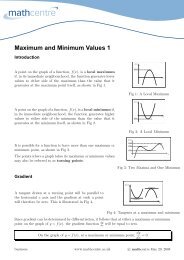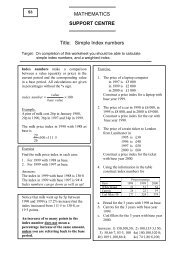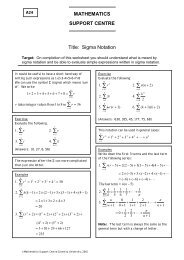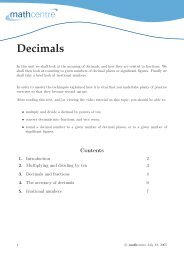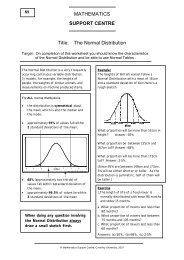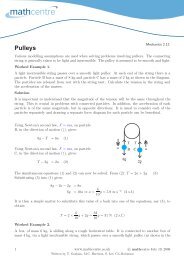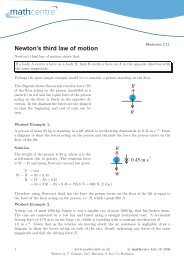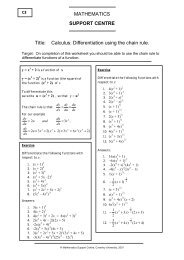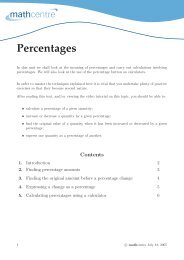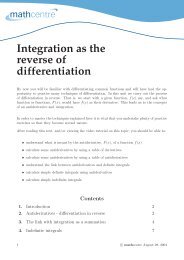Cartesian components of vectors
Cartesian components of vectors
Cartesian components of vectors
You also want an ePaper? Increase the reach of your titles
YUMPU automatically turns print PDFs into web optimized ePapers that Google loves.
<strong>Cartesian</strong> <strong>components</strong><br />
<strong>of</strong> <strong>vectors</strong><br />
Any vector may be expressed in <strong>Cartesian</strong> <strong>components</strong>, by using unit <strong>vectors</strong> in the directions<br />
<strong>of</strong> the coordinate axes. In this unit we describe these unit <strong>vectors</strong> in two dimensions and in<br />
three dimensions, and show how they can be used in calculations.<br />
In order to master the techniques explained here it is vital that you undertake plenty <strong>of</strong> practice<br />
exercises so that they become second nature.<br />
After reading this text, and/or viewing the video tutorial on this topic, you should be able to:<br />
• identify the coordinate unit <strong>vectors</strong> in two dimensions and in three dimensions;<br />
• determine whether a set <strong>of</strong> coordinate axes in three dimensions is labelled as a right-handed<br />
system;<br />
• express the position vector <strong>of</strong> a point in terms <strong>of</strong> the coordinate unit <strong>vectors</strong>, and as a<br />
column vector;<br />
• calculate the length <strong>of</strong> a position vector, and the angle between a position vector and a<br />
coordinate axis;<br />
• write down a unit vector in the same direction as a given position vector;<br />
• express a vector between two points in terms <strong>of</strong> the coordinate unit <strong>vectors</strong>.<br />
Contents<br />
1. Vectors in two dimensions 2<br />
2. Vectors in three dimensions 3<br />
3. The length <strong>of</strong> a position vector 5<br />
4. The angle between a position vector and an axis 6<br />
5. An example 8<br />
1 c○ mathcentre July 18, 2005
1. Vectors in two dimensions<br />
The natural way to describe the position <strong>of</strong> any point is to use <strong>Cartesian</strong> coordinates. In two<br />
dimensions, we have a diagram like this, with an x-axis and a y-axis, and an origin O. To include<br />
<strong>vectors</strong> in this diagram, we have a vector î associated with the x-axis and a vector ĵ associated<br />
with the y-axis.<br />
y<br />
P<br />
(3, 4)<br />
j<br />
O<br />
i<br />
x<br />
If we take any point in this diagram, for instance the point P with coordinates (3, 4), then we<br />
can write<br />
OP = 3î + 4ĵ.<br />
It is important to appreciate the difference between these two expressions. The numbers (3, 4)<br />
represent a set <strong>of</strong> coordinates, referring to the point P. But the expression 3î + 4ĵ is a vector,<br />
the position vector OP. An alternative way <strong>of</strong> writing this is as a “column vector”:<br />
(<br />
3<br />
4<br />
)<br />
means the same as 3î + 4ĵ.<br />
Sometimes one notation is used, and sometimes the other.<br />
Key Point<br />
In two dimensions, the unit <strong>vectors</strong> in the directions <strong>of</strong> the two coordinate axes are written as<br />
î and ĵ. If a point P has coordinates (x, y) then the position vector OP may be written as a<br />
combination <strong>of</strong> these unit <strong>vectors</strong>,<br />
OP = xî + yĵ,<br />
or equivalently as a column vector<br />
( x<br />
OP =<br />
y<br />
)<br />
.<br />
c○ mathcentre July 18, 2005 2
2. Vectors in three dimensions<br />
In three dimensions we have three axes, traditionally labelled x, y and z, all at right angles to<br />
each other. Any point P can now be described by three numbers, the coordinates with respect<br />
to the three axes.<br />
z<br />
O<br />
y<br />
x<br />
Now there might be other ways <strong>of</strong> labelling the axes. For instance we might interchange x and<br />
y, or interchange y and z. But the labelling in the diagram is a standard one, and it is called a<br />
right-handed system.<br />
Imagine a right-handed screw, pointing along the z-axis. If you tighten the screw, by turning it<br />
from the positive x-axis towards the positive y-axis, then the screw will move along the z-axis.<br />
The standard system <strong>of</strong> labelling is that the direction <strong>of</strong> movement <strong>of</strong> the screw should be the<br />
positive z direction.<br />
z<br />
O<br />
y<br />
x<br />
This works whichever axis we choose to start with, so long as we go round the cycle x, y, z,<br />
and then back to x again. For instance, if we start with the positive y-axis, then turn the screw<br />
towards the positive z-axis, then we’ll tighten the screw in the direction <strong>of</strong> the positive x-axis.<br />
Key Point<br />
A right-handed system is a set <strong>of</strong> three axes, labelled so that rotating a screw from the positive<br />
x-axis towards the positive y-axis will tighten the screw in the direction <strong>of</strong> the positive z-axis.<br />
3 c○ mathcentre July 18, 2005
Now let’s take a point P in three-dimensional space, with coordinates (x, y, z). The position<br />
vector <strong>of</strong> the point will be the line segment OP.<br />
z<br />
P (x, y, z)<br />
O<br />
y<br />
x<br />
We can now write<br />
OP = xî + yĵ + zˆk<br />
where ˆk is a unit vector in the direction <strong>of</strong> the z-axis. Again it is important to appreciate the<br />
difference. The numbers (x, y, z) represent a set <strong>of</strong> coordinates, referring to the point P. But<br />
the expression xî + yĵ + zˆk is a vector, the position vector OP. We sometimes write this is as<br />
a column vector: ⎛ ⎞<br />
x<br />
⎝ y ⎠ means the same as xî + yĵ + zˆk.<br />
z<br />
Key Point<br />
In three dimensions, the unit <strong>vectors</strong> in the directions <strong>of</strong> the three coordinate axes are written<br />
as î, ĵ and ˆk. If a point P has coordinates (x, y, z) then the position vector OP may be written<br />
as a combination <strong>of</strong> these unit <strong>vectors</strong>,<br />
OP = xî + yĵ + zˆk,<br />
or equivalently as a column vector<br />
⎛<br />
OP = ⎝<br />
x<br />
y<br />
z<br />
⎞<br />
⎠.<br />
c○ mathcentre July 18, 2005 4
3. The length <strong>of</strong> a position vector<br />
What is the length <strong>of</strong> the position vector OP ?<br />
To answer this question, we start by dropping a perpendicular from P down to the (x, y)-plane.<br />
We shall call this new point Q. Then we join the point Q up to the x and y axes, again at right<br />
angles. We shall call the two new points A and B.<br />
z<br />
P (x, y, z)<br />
O<br />
B<br />
y<br />
A<br />
Q<br />
x<br />
Now we know some <strong>of</strong> the lengths in this diagram. First, the length PQ is the height <strong>of</strong> the<br />
point P above the (x, y)-plane. So that length must be z.<br />
The length OA is the distance along the x coordinate axis, so that length must be x. And the<br />
length BQ is the same as the length OA, so that must also be x.<br />
In the same way, the length OB is the distance along the y coordinate axis, so that length must<br />
be y. And the length AQ is the same as the length OB, so that must also be y.<br />
z<br />
P (x, y, z)<br />
z<br />
A<br />
O<br />
x<br />
y<br />
Q<br />
y<br />
x<br />
B<br />
y<br />
x<br />
Now we join the points O and Q. Then OAQ is a right-angled triangle, and so is OBQ. So the<br />
length OQ can be found by using Pythagoras’s Theorem, in either <strong>of</strong> these triangles. We obtain<br />
the formula<br />
OQ = √ OA 2 + AQ 2<br />
= √ x 2 + y 2 .<br />
(or<br />
√<br />
OB2 + BQ 2 )<br />
Now we can use the right-angled triangle OQP. If we apply Pythagoras’s Theorem to this<br />
5 c○ mathcentre July 18, 2005
triangle, we obtain<br />
OP = √ OQ 2 + QP 2<br />
=<br />
√ ( √<br />
x2 + y 2 ) 2<br />
+ z<br />
2<br />
= √ x 2 + y 2 + z 2 .<br />
Key Point<br />
If P is the point with coordinates (x, y, z) then the length, or magnitude, <strong>of</strong> the position vector<br />
OP is given by the formula<br />
|OP | = OP = √ x 2 + y 2 + z 2 .<br />
4. The angle between a position vector and an axis<br />
z<br />
P (x, y, z)<br />
P<br />
A<br />
O<br />
Q<br />
B<br />
y<br />
O<br />
α<br />
A<br />
x<br />
Now we have found the length <strong>of</strong> the line OP: it is √ x 2 + y 2 + z 2 . And we also know the length<br />
<strong>of</strong> the line OA: it is x. But the triangle POA is a right-angled triangle, so we can write down<br />
the cosine <strong>of</strong> the angle POA. If we call this angle α, then<br />
cosα =<br />
x<br />
√<br />
x2 + y 2 + z 2.<br />
The quantity cosα is known as a direction cosine, because it is the cosine <strong>of</strong> an angle which<br />
helps to specify the direction <strong>of</strong> P; α is the angle that the position vector OP makes with the<br />
x-axis.<br />
c○ mathcentre July 18, 2005 6
Of course we can do the same for the y-axis and for the z-axis. We obtain<br />
cosβ =<br />
y<br />
√<br />
x2 + y 2 + z 2<br />
where β is the angle that OP makes with the y-axis, and<br />
cosγ =<br />
z<br />
√<br />
x2 + y 2 + z 2.<br />
where γ is the angle that OP makes with the z-axis.<br />
Key Point<br />
The direction cosines <strong>of</strong> the point P describe the angles between the position vector OP and<br />
the three axes. If P has coordinates (x, y, z) then the direction cosines are given by<br />
cos α =<br />
x<br />
√<br />
x2 + y 2 + z 2, cosβ = y<br />
√<br />
x2 + y 2 + z 2, cosγ = z<br />
√<br />
x2 + y 2 + z 2.<br />
Now we can find an interesting formula if we take the three direction cosines, square them, and<br />
add them. What is<br />
cos 2 α + cos 2 β + cos 2 γ?<br />
Well,<br />
so that<br />
cos 2 α =<br />
x 2<br />
x 2 + y 2 + z 2, cos2 β =<br />
y 2<br />
x 2 + y 2 + z 2, cos2 γ =<br />
cos 2 α + cos 2 β + cos 2 γ = x2 + y 2 + z 2<br />
x 2 + y 2 + z 2<br />
= 1.<br />
z 2<br />
x 2 + y 2 + z 2<br />
So the squares <strong>of</strong> the direction cosines, when added together, equal 1. What use could this be?<br />
In fact it tells us that the vector<br />
cosαî + cosβ ĵ + cosγ ˆk<br />
is a unit vector. That is because the magnitude <strong>of</strong> this vector is the square root <strong>of</strong> the quantity<br />
cos 2 α + cos 2 β + cos 2 γ, which we have just seen is equal to 1. And this vector is also in the<br />
same direction as our original vector OP, because the three numbers cosα, cosβ and cos γ are<br />
in the same ratio as x, y and z. So we have found a unit vector in the direction <strong>of</strong> our original<br />
position vector OP.<br />
7 c○ mathcentre July 18, 2005
Key Point<br />
The direction cosines <strong>of</strong> any point P satisfy the equation<br />
cos 2 α + cos 2 β + cos 2 = 1.<br />
A unit vector in the same direction as the position vector OP is given by the expression<br />
cosαî + cos β ĵ + cosγ ˆk.<br />
5. An example<br />
Suppose we have a point A with coordinates (1, 0, 2) and another point B with coordinates<br />
(2, −1, 4). We can then form the vector AB. Now what is the magnitude <strong>of</strong> this vector, and<br />
what are its direction cosines?<br />
We can answer these questions by writing the two position <strong>vectors</strong> OA and OB in terms <strong>of</strong> the<br />
unit <strong>vectors</strong> î, ĵ and ˆk. We obtain<br />
OA = î + 2ˆk<br />
OB = 2î − ĵ + 4ˆk.<br />
B<br />
A<br />
So<br />
O<br />
AB = AO + OB<br />
= OB − OA<br />
= (2î − ĵ + 4ˆk) − (î + 2ˆk).<br />
Now when we subtract expressions involving the unit <strong>vectors</strong> î, ĵ and ˆk we just subtract the<br />
corresponding <strong>components</strong> separately. So<br />
AB = (2î − î) + (−ĵ) + (4ˆk − 2ˆk)<br />
= î − ĵ + 2ˆk.<br />
c○ mathcentre July 18, 2005 8
With this expression for the vector AB, we can calculate its magnitude. It is<br />
|AB| = AB = √ 1 2 + (−1) 2 + 2 2 = √ 6.<br />
We can also calculate the three direction cosines <strong>of</strong> AB. They are<br />
Exercises<br />
cosα = 1 √<br />
6<br />
,<br />
1. Find the lengths <strong>of</strong> each <strong>of</strong> the following <strong>vectors</strong><br />
(a) 2î + 4ĵ + 3ˆk<br />
(b) 5î − 2ĵ + ˆk<br />
(c) 2ĵ − ˆk<br />
(d) 5î<br />
(e) 3î − 2ĵ − ˆk<br />
(f) î + ĵ + ˆk<br />
cos β = −1 √<br />
6<br />
, cosγ = 2 √<br />
6<br />
.<br />
2. Find the angles giving the direction cosines <strong>of</strong> the <strong>vectors</strong> in Question 1.<br />
3. Determine the vector AB for each <strong>of</strong> the following pairs <strong>of</strong> points<br />
(a) A (3,7,2) and B (9,12,5)<br />
(b) A (4,1,0) and B (3,4,-2)<br />
(c) A (9,3,-2) and B (1,3,4)<br />
(d) A (0,1,2) and B (-2,1,2)<br />
(e) A (4,3,2) and B (10,9,8)<br />
4. For each <strong>of</strong> the <strong>vectors</strong> found in Question 3, determine a unit vector in the direction <strong>of</strong><br />
AB<br />
Answers<br />
1.<br />
(a)<br />
√<br />
29 (b)<br />
√<br />
30 (c)<br />
√<br />
5 (d) 5 (e)<br />
√<br />
14 (f)<br />
√<br />
3<br />
2.<br />
(a) 68.2 ◦ , 42.0 ◦ , 56.1 ◦ (b) 24.1 ◦ , 111.4 ◦ , 79.5 ◦<br />
(c) 90 ◦ , 26.6 ◦ , 116.6 ◦ (d) 0 ◦ , 90 ◦ , 90 ◦<br />
(e) 36.7 ◦ , 122.3 ◦ , 105.5 ◦ (f) 54.7 ◦ , 54.7 ◦ , 54.7 ◦<br />
3.<br />
(a) 6î + 5ĵ + 3ˆk (b) −î + 3ĵ − 2ˆk (c) −8î + 6ˆk (d) −2î<br />
(e) 6î + 6ĵ + 6ˆk<br />
4.<br />
(a)<br />
1<br />
√ (6î + 5ĵ + 3ˆk) (b)<br />
70<br />
1<br />
√ (−î + 3ĵ − 2ˆk) (c)<br />
14<br />
(d) −î (e) 1 √3 (î + ĵ + ˆk)<br />
1<br />
(−8î + 6ˆk)<br />
10<br />
9 c○ mathcentre July 18, 2005


